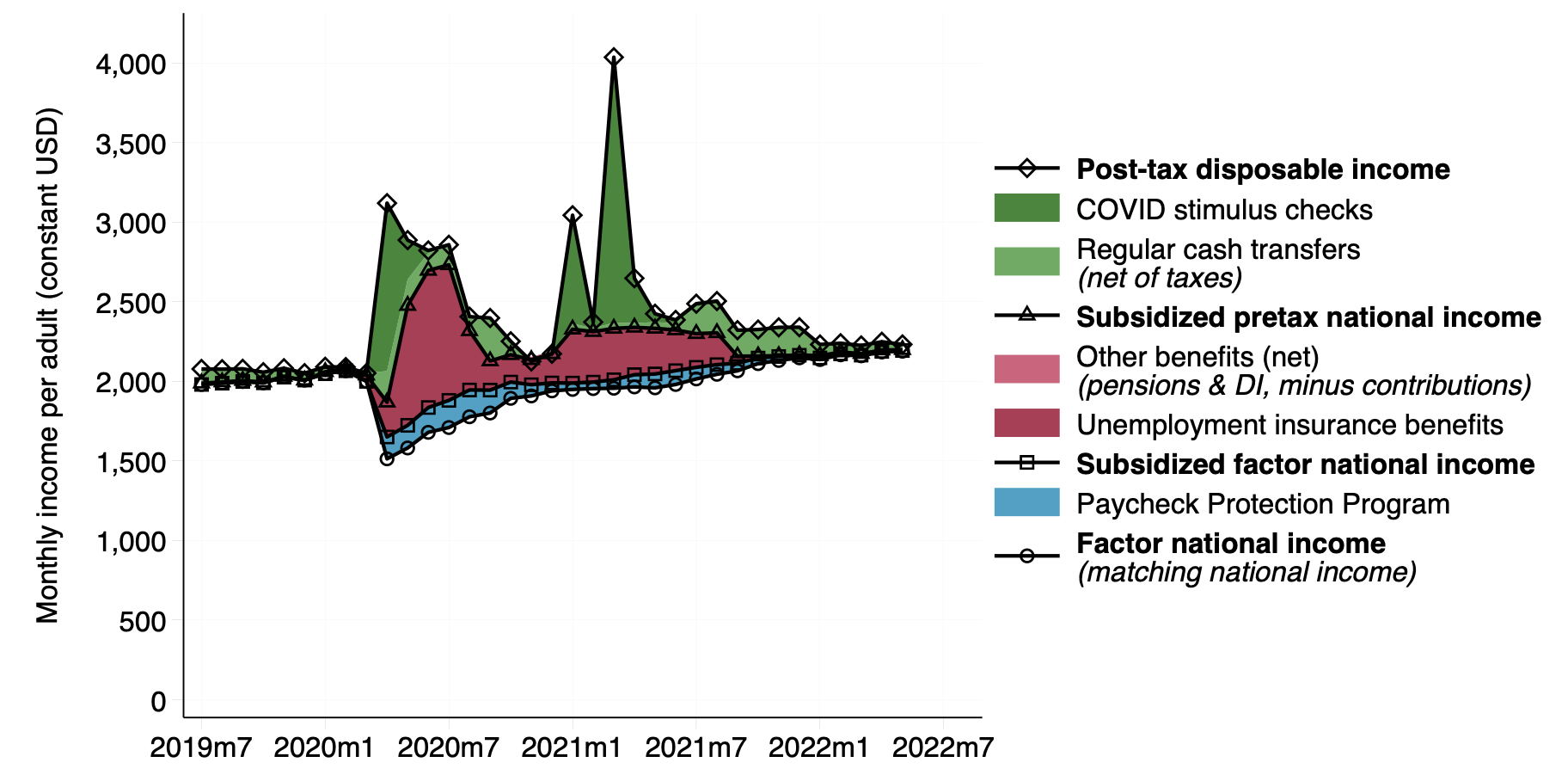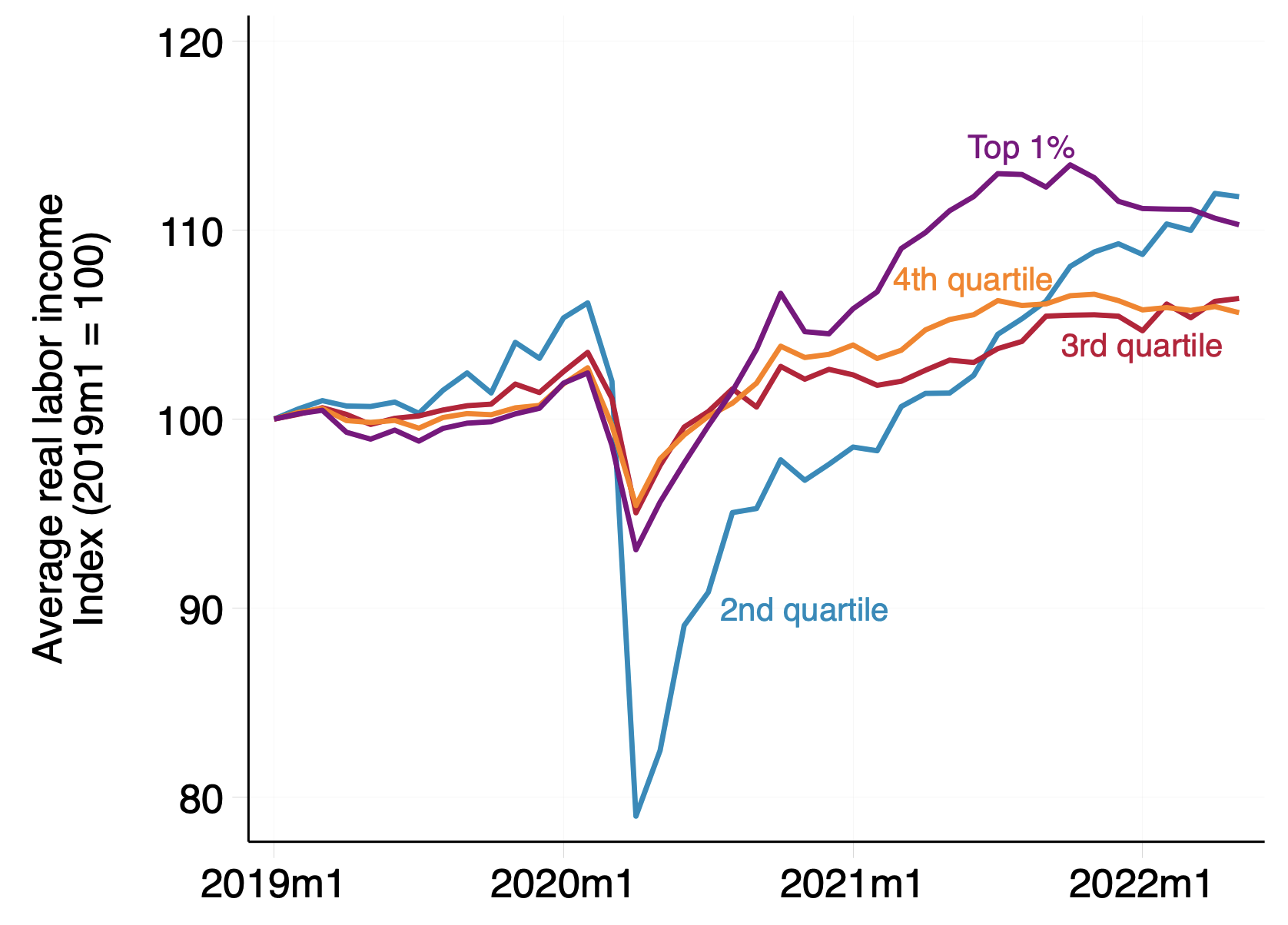A major gap in the economic statistics of governments around the world is the lack of timely information on the distribution of income. While detailed macroeconomic data—ranging from quarterly national accounts to high-frequency labour market statistics—are published almost in real time, they are not disaggregated by income level. We know how GDP evolves quarterly, but we do not know which social groups benefit from this growth, or which are most affected by economic crises as they unfold. Today, for example, inflation in the US is at its highest since the beginning of the 1980s (e.g. Bolhuis et al. 2022). But the distributional effects of this inflationary episode are not yet known. Are real wages rising despite inflation, and if so for which socioeconomic groups? Have all groups of the population recovered from the Covid-19 crisis, or are some of them still below their pre-crisis income level?
The lack of timely inequality statistics relative to growth statistics tilts the public debate on the state of the economy toward macroeconomic growth concerns and away from distributional considerations. In a recent paper (Blanchet et al. 2022), we attempt to address this discrepancy by creating high-frequency and timely distributions of income in the US. We propose a methodology to combine the information contained in high-frequency public data sources, including monthly household and employment surveys, quarterly censuses of employment and wages, and monthly and quarterly national accounts series. The outcome of this research is a set of monthly micro-files in which an observation is a synthetic adult (obtained by statistically matching public micro-data) and variables include income and its components. These variables add up to their respective national accounts totals and their distributions are consistent with those observed in the raw input data. Using these files, we can estimate quarterly and even monthly economic growth by social group as soon as official macroeconomic growth statistics are released.
Following a recession, it becomes possible to estimate ‘distributional output gaps’, that is, the extent to which income remains below its pre-recession level or trend for the bottom 50% of the distribution, the next 40%, and the top 10%. Since our files incorporate comprehensive tax and government transfer variables, they can be used to monitor how losses for different social groups during a crisis are mitigated by stabilisation policies as they are implemented.
Our files and real-time distributional growth statistics, available at https://realtimeinequality.org are updated with each release of the national accounts, within a few hours. We automated the code and website with a view to being able to provide high-frequency updates sustainably. This should allow us to analyse future business cycles in real time, maximising the usefulness of this tool for economists, policymakers, and the broader public. In the meantime, we can use this new tool to analyse the recent dynamic of the US economy post-Covid. Three striking findings emerge.
First, while all groups, particularly the bottom 50% and the top 1%, experienced sharp losses in pre-tax income at the onset of the covid crisis, all social groups recovered their real pre-crisis pre-tax income levels within 20 months (Figure 1). The recovery was much more equal than the recovery from the Great Recession of 2008–2009, during which it took nearly ten years for the bottom 50% to recover its pre-crisis pre-tax income level—even though GDP per adult recovered in four years. The Covid recovery was also more equal across gender and racial groups. These findings illustrate the fact that a given trajectory of GDP growth is compatible with widely different market income dynamics for the various social groups, highlighting the usefulness of timely distributional growth statistics.
Figure 1 Real pre-tax income growth across the distribution during Covid-19
Notes: This figure shows the monthly dynamic of real factor income (capital and labour income before taxes) per adult (with income equally split among married spouses) around the Covid-19 pandemic. The pandemic led to the strongest income declines for the bottom 50% and the top one percent. By October 2021 all groups had recovered their pre-crisis income level.
Second, government programmes enacted during the pandemic led to unprecedented—but short-lived—improvements in living standards for the working class (Figure 2). After accounting for taxes and cash and quasi-cash transfers, disposable income for adults in the bottom 50% was 20% higher in 2021 than in 2019. In particular, the extremely generous unemployment insurance supplements ($600/week from April to July 2020 and $300/week from January to August 2021) more than compensated the bottom 50% for their lost earnings due to the Covid crisis. When adding the expanded extra child tax credit and earning income tax credit and especially the Covid stimulus cheques, the disposable income of the bottom 50% soared temporarily. These massive transfers toward the bottom 50% were much larger than in other advanced economies. This demonstrates the enormous power of the government to redistribute incomes. However, disposable income of the bottom 50% fell in the beginning of 2022, as the expansion of the welfare state enacted during the pandemic—notably the expanded child tax credit and earned income tax credit—was rolled back. The only reason why disposable income for the bottom 50% was higher in 2022 than in 2019 (by about 10% in real terms) was the higher market income for this group, driven by wage gains.
Figure 2 Pre-tax versus disposable real income of the bottom 50% during Covid
Notes: This figure decomposes the average real monthly income of the bottom 50% from July 2019 to May 2022. We restrict to the working-age population (aged 20 to 64). Individual adults are ranked by their factor income (labour and capital income before taxes), and income is equally split between married spouses. The figure reveals the relative importance of the different government programs enacted during the Covid-19 pandemic, most importantly the three waves of Covid-relief payments (April 2020, January 2021, and March 2021), the expansion of unemployment insurance, the expansion of refundable tax credits (EITC and child tax credit), and the Paycheck Protection Program. By the beginning of 2022 all of these programs had expired, and the only reason why average bottom 50% disposable income remained higher than pre-Covid (by about 10%) was the higher level of factor income.
Third, tight labour markets in the Covid recovery benefitted low-paid workers, whose pay gains beat the high inflation. Figure 3 shows the evolution of real labour income per adult among the working age population (age 20-64) by quartile from January 2019 to May 2022. Focusing on the full working-age population including non-workers captures both wage growth and employment growth. Because approximately a quarter of working-age adults do not work (and hence have no earnings), we exclude the bottom quartile from the figure. Hence, the second quartile corresponds to low paid workers. Real earnings for this group drop precipitously during Covid, due to enormous job losses. However, this group recovers very fast. It has even experienced real earnings growth during 2022 at a time of fast inflation while other groups have seen no real growth in 2022.
Between January 2019 and May 2022—two months with nearly equal employment rates among the working age population at the macro-level—real average labour income for low-wage workers increased by more than 10%, faster than for all other groups of the population. Thus, the Covid recovery was characterised by a reduction in wage inequality, a break from the trend prevailing since the early 1980s that highlights the equalizing effects of a tightest labour market in the US since WWII (Michaillat and Saez 2022).
Figure 3 Earnings growth across the distribution during Covid
Notes: This figure depicts the average real labor income of the second, third, and forth quartile, and the top 1% of the labor income distribution among adults aged 20 to 64 (including non-workers) from January 2019 (base 100) to May 2022. Labor income is individualized (i.e., not equally split between married spouses) and includes all wages and salaries, supplements to wages and salaries, and 70% of self-employment income. The first quartile is not depicted because approximately ¼ of adults aged 20 to 64 do not work. The second quartile corresponds to low paid workers. Low paid workers have continued to make real wage gains, in spite of high inflation in 2022.
Because our methodology only uses public data, it can easily be replicated, tested, and extended. Looking forward, it could be enriched by combining administrative datasets within government agencies or by incorporating additional data sources, such as private sector information (Chetty et al. 2020). We view our paper as constructing a prototype of real-time distributions combining all currently publicly available data source—a prototype that could be refined using additional data and eventually incorporated into official national account statistics. Our methodology could also be implemented in other countries, thus improving our ability to understand business cycles throughout the world.
References
Blanchet, T, E Saez, and GabrSiel Zucman (2022), “Real-Time Inequality”, NBER Working Paper No. 30229.
Bolhuis, M A, J N L Cramer, and L H Summers (2022), “Past and present inflation are more similar than you think”, VoxEU.org, 22 June.
Chetty, R, J N Friedman, N Hendren, M Stepner, and the Opportunity Insights Team (2020), “The Economic Impacts of Covid-19: Evidence from a New Public Database Built Using Private Sector Data”, NBER Working Paper No. 27431.
Michaillat, P and E Saez (2022) “Figuring out efficient unemployment”, VoxEU.org, 19 April.









